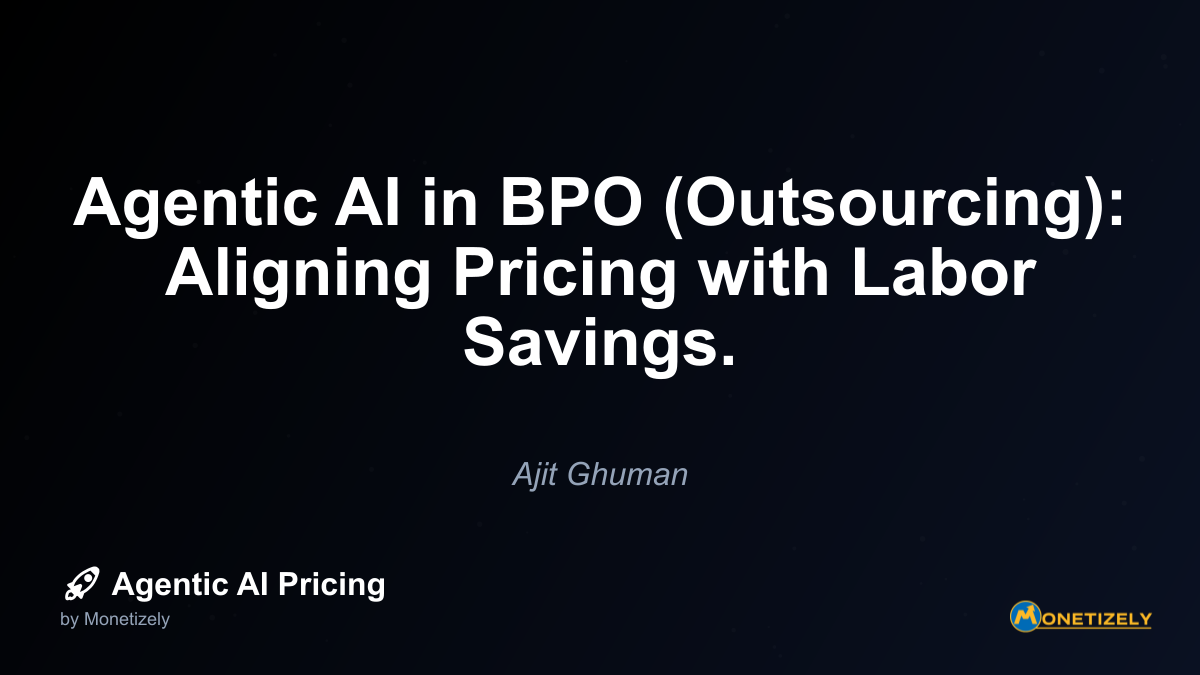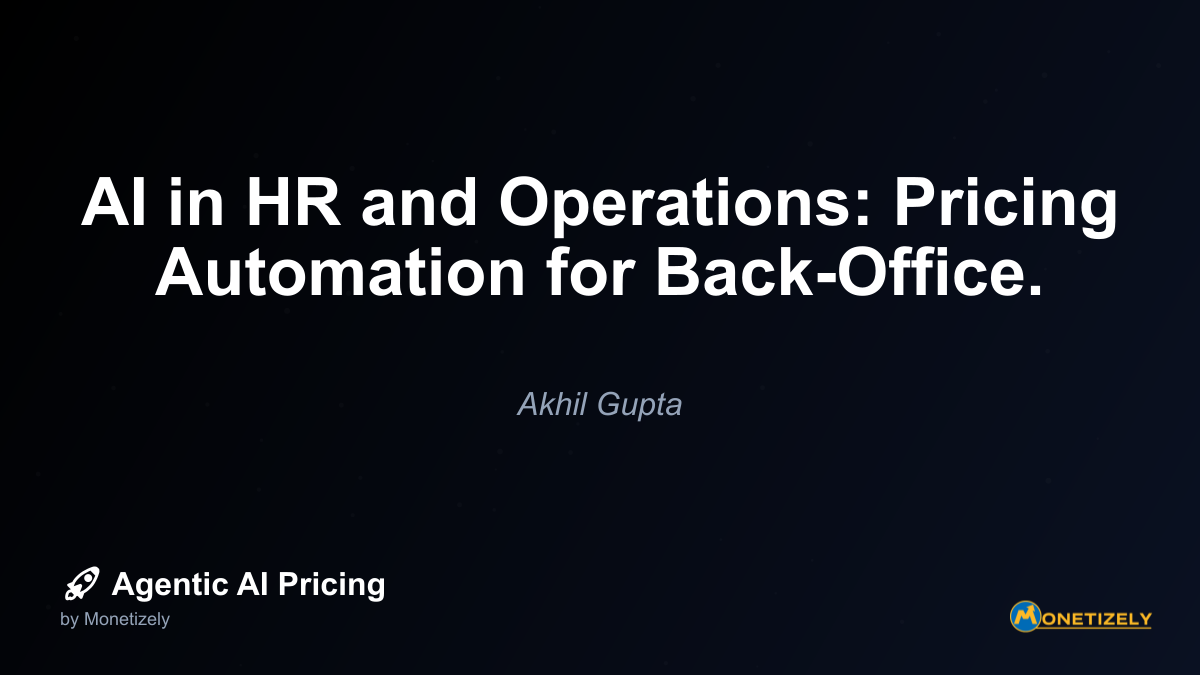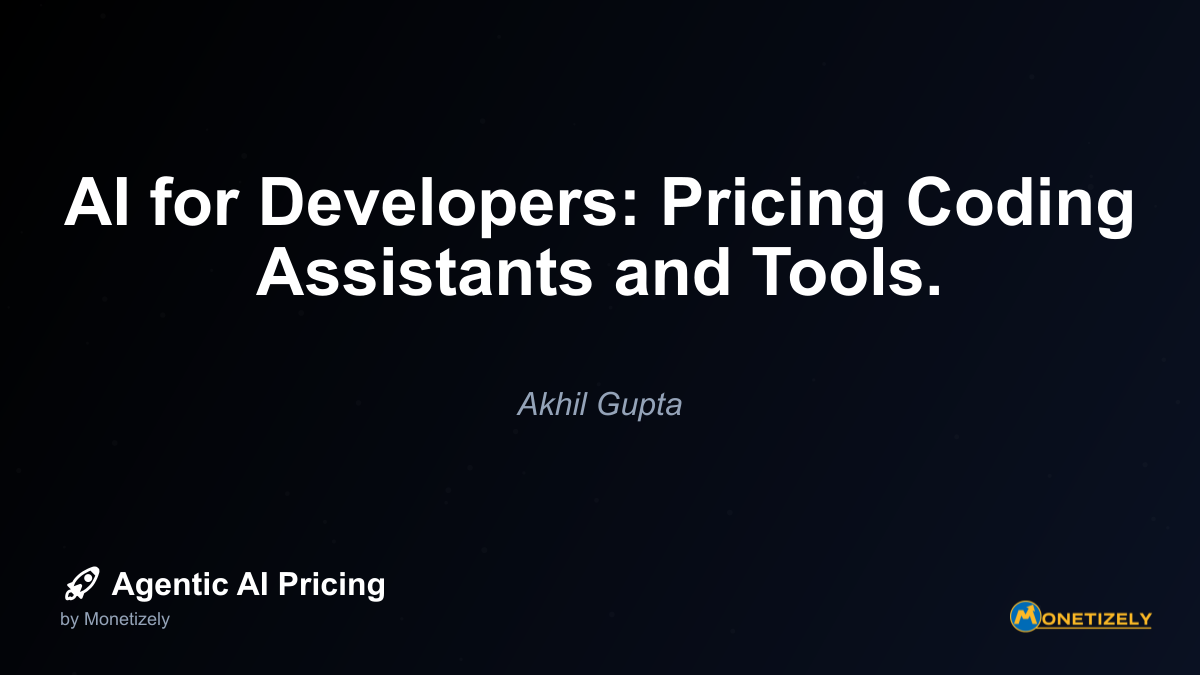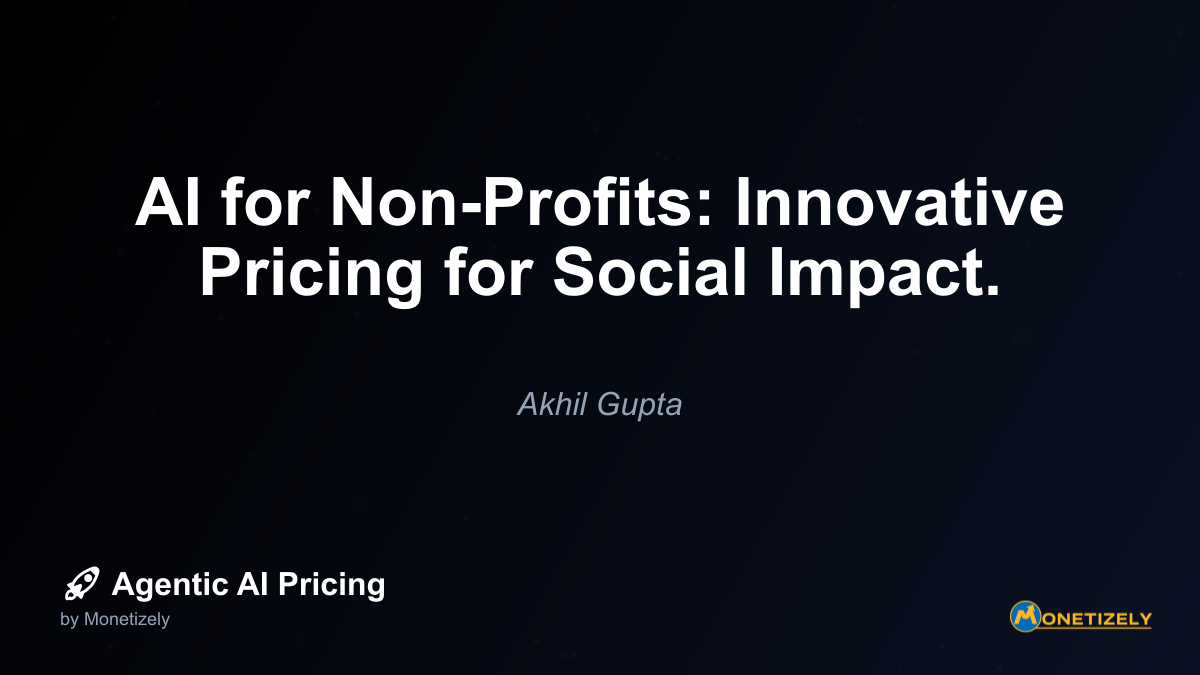· Ajit Ghuman · Industry Insights · 12 min read
Agentic AI in BPO (Outsourcing): Aligning Pricing with Labor Savings.
AI and SaaS Pricing Masterclass
Learn the art of strategic pricing directly from industry experts. Our comprehensive course provides frameworks and methodologies for optimizing your pricing strategy in the evolving AI landscape. Earn a professional certification that can be imported directly to your LinkedIn profile.

In the rapidly evolving landscape of business process outsourcing (BPO), a significant transformation is underway. The integration of agentic AI technologies is fundamentally reshaping how BPO firms operate, deliver services, and—perhaps most critically—how they structure their pricing models. This shift represents not merely an operational evolution but a strategic reimagining of the value proposition that BPOs offer to their clients.
Traditionally, BPO pricing has been predominantly built around per-seat or full-time equivalent (FTE) models, where clients pay for the human resources dedicated to their processes. However, as agentic AI systems increasingly automate tasks previously performed by human agents, this pricing approach has become increasingly misaligned with the actual value delivery mechanism and cost structure of modern BPO operations.
This article explores how BPO firms are navigating this transition, examining the complex interplay between AI-driven labor savings and emerging pricing models that better reflect the new reality of service delivery in the age of autonomous AI agents.
The Evolution of BPO Pricing Models
Traditional Per-Seat Pricing: The Legacy Approach
The BPO industry has historically operated on a labor arbitrage model, with pricing directly tied to human resources. Under traditional per-seat pricing, clients pay for:
- A fixed rate per employee (seat) assigned to their processes
- Hourly rates for work performed by human agents
- Headcount-based pricing with volume discounts
- Location-based pricing tiers reflecting different labor markets
This approach made intuitive sense when human labor was the primary input cost and value driver for BPO providers. The more people needed to perform a client’s work, the higher the cost. This created a direct, transparent relationship between service delivery resources and pricing.
The AI Disruption: Why Per-Seat Models Are Breaking Down
The introduction of agentic AI—autonomous AI systems capable of performing complex tasks with minimal human intervention—is fundamentally disrupting this equation. According to research from McKinsey, agentic AI can transform entire business processes, creating new revenue streams and competitive advantages while significantly reducing the need for human involvement.
This creates a pricing paradox: as BPO providers invest in AI to become more efficient, they effectively reduce the very metric (headcount) upon which their revenue model is based. This misalignment creates several challenges:
- Diminishing revenue despite increased value delivery: As AI reduces necessary headcount, revenue decreases under per-seat models even as service quality and efficiency improve
- Misaligned incentives: Per-seat pricing disincentivizes BPO providers from maximizing automation
- Value capture issues: Clients receive the efficiency benefits while providers bear the technology investment costs
- Competitive disadvantage: BPO firms that aggressively adopt AI may price themselves out of the market under traditional models
The data highlights this disconnect. According to BCG research, enterprises using AI-enabled BPO services have observed seat reductions as a primary cost lever, with some seeing a 40% decrease in software spend by leveraging agentic AI capabilities that reduce human involvement.
Emerging Transaction and Outcome-Based Models
In response to these challenges, forward-thinking BPO providers are shifting toward transaction-based and outcome-based pricing models that better align with the value delivered through AI-augmented services.
Transaction-Based Pricing
Transaction-based pricing ties costs directly to the volume of work processed rather than the resources used to process it. This model includes:
- Per-transaction fees (e.g., per invoice processed, per customer ticket resolved)
- Tiered volume pricing with declining per-unit costs at higher volumes
- Hybrid models with minimum transaction commitments
This approach better reflects the scalability of AI systems, which can handle increased transaction volumes with minimal marginal cost increases. For example, DRUID AI, which offers an enterprise-grade agentic AI framework for BPOs, emphasizes autonomous end-to-end workflow execution with pricing based on completed transactions or workflows rather than seats.
Outcome-Based Pricing
Taking the evolution further, outcome-based pricing directly ties costs to the business results achieved:
- Performance-based fees tied to specific KPIs (e.g., cost savings, error reduction)
- Revenue or profit-sharing arrangements
- Risk/reward models with penalties for underperformance and bonuses for exceeding targets
- Value-based pricing reflecting the client’s realized benefits
This approach most closely aligns provider compensation with client value. For instance, according to Everest Group research, the rapid adoption of agentic AI is driven by its ability to drive productivity and cost savings, leading to strategic outcomes. Enterprises are now focused on quickly piloting agentic AI to assess feasibility and ROI, with pricing increasingly tied to these measurable outcomes.
Measuring and Quantifying AI-Driven Labor Savings
For BPO firms transitioning to transaction or outcome-based pricing models, accurately measuring and quantifying the labor savings achieved through AI implementation is critical for setting appropriate rates and demonstrating value to clients.
Key Metrics for Quantifying Labor Efficiency Gains
Research reveals several key metrics BPO providers are using to measure AI-driven labor savings:
- Task Automation Rate: The percentage of tasks previously performed by humans now handled by AI
- Time Savings: Reduction in processing time per transaction or workflow
- Labor Hour Reduction: Total reduction in human labor hours required
- Error Rate Reduction: Decrease in errors requiring human intervention
- Volume Capacity Increase: Increase in transaction volume capacity without additional human resources
These metrics provide concrete evidence of efficiency gains. For example, AI-driven automation in BPOs can reduce labor hours by up to 30-50% on repetitive transactional processes such as invoice matching, data entry, and case management, according to industry research.
Case Studies: Quantified Labor Savings
Several real-world implementations demonstrate the magnitude of labor savings possible through agentic AI:
H&M’s Virtual Shopping Assistant: Implemented an AI agent that resolves 70% of customer queries autonomously, achieves 3× faster resolution time, and boosts conversion rates by 25% during chatbot interactions. This reduced customer support costs substantially while increasing revenue per visitor.
Bank of America’s AI Chatbot (Erica): Reduced call center load by 30% while improving customer experience, leading to significant cost savings and higher satisfaction.
Direct Mortgage Corp.: AI agents integrated for loan processing cut costs by 80% and sped up application approvals by 20× via document classification and automated data extraction.
These examples illustrate that labor savings from AI implementation can be substantial and measurable, providing a solid foundation for new pricing models.
Implementing Transaction-Based Pricing Models
With a clear understanding of AI-driven labor savings, BPO providers can design and implement transaction-based pricing models that better reflect their new cost structures and value proposition.
Designing Effective Transaction-Based Models
Effective transaction-based pricing requires careful consideration of several factors:
- Transaction Definition: Clearly defining what constitutes a “transaction” (e.g., a processed invoice, a resolved customer query, a completed application)
- Volume Tiers: Creating appropriate volume tiers that reflect economies of scale
- Complexity Factors: Accounting for varying transaction complexity
- Service Level Agreements (SLAs): Incorporating performance guarantees
- Minimum Commitments: Establishing baseline volume commitments
According to industry research, seat-based models have declined from 21% to 15% of companies in 12 months, while hybrid (seat + usage/outcome) pricing has surged from 27% to 41%. This indicates a clear industry trend toward transaction and outcome-based approaches.
Pricing Calculation Methodologies
BPO providers are using several methodologies to calculate transaction-based pricing:
- Cost-Plus Approach: Starting with the provider’s costs (including AI infrastructure, remaining human labor, and overhead) and adding a margin
- Market-Based Approach: Benchmarking against market rates for similar services
- Value-Based Approach: Setting prices based on a percentage of the value delivered to clients
Research from Piton Global suggests that leading BPOs are adopting data-driven, multidimensional pricing that goes beyond lowest-cost competition and static rate cards. Instead, they position as co-investors aligned with client outcomes and digital transformation goals.
Addressing Client Concerns
When transitioning to transaction-based pricing, BPO providers must address several common client concerns:
- Cost Predictability: 36% of clients worry about variable cost exposure under usage/outcome models
- Budget Planning: Helping clients plan for variable costs
- Value Demonstration: Clearly showing how the new pricing model delivers better value
To address these concerns, providers can:
- Offer caps or collars on monthly transaction costs
- Provide detailed reporting and analytics on transaction volumes and costs
- Implement pilot periods to demonstrate value before full implementation
Implementing Outcome-Based Pricing Models
Outcome-based pricing represents the most advanced evolution in BPO pricing models, directly tying provider compensation to client business results.
Designing Effective Outcome-Based Models
Effective outcome-based pricing requires:
- Clear Outcome Definition: Precisely defining the outcomes that will drive pricing
- Measurement Methodology: Establishing how outcomes will be measured
- Baseline Determination: Setting performance baselines
- Risk/Reward Structure: Defining how risk and reward will be shared
- Governance Framework: Creating mechanisms for dispute resolution and performance verification
According to research, 47% of buyers struggle to agree on outcomes to base pricing on, highlighting the importance of clear definitions and measurement methodologies.
Common Outcome Metrics
BPO providers are using various outcome metrics as the basis for pricing:
- Cost Reduction: Measured savings in client operational costs
- Revenue Increase: Growth in client revenue attributable to BPO services
- Quality Improvement: Reduction in errors or defects
- Compliance Enhancement: Improved regulatory compliance rates
- Customer Satisfaction: Increases in customer satisfaction scores
For example, AI value measurement is increasingly based on metrics such as the number of transactions processed autonomously, time-to-resolution improvements, error rate reductions, and compliance adherence achieved.
Risk Mitigation Strategies
Outcome-based pricing introduces additional risk for both providers and clients. Mitigation strategies include:
- Hybrid Models: Combining outcome-based components with baseline fees
- Phased Implementation: Gradually increasing the outcome-based portion of pricing
- Pilot Programs: Testing outcome-based pricing on a limited scope before full implementation
- Joint Governance: Establishing joint committees to oversee performance measurement
Research indicates that risk/reward sharing arrangements are emerging as strategic partnerships, balancing responsibility for success between BPO and client. Key features include shared savings or revenue splits tied to process enhancements or cost reductions.
Technical Considerations for AI-Driven Pricing Models
The technical infrastructure supporting AI implementations has significant implications for pricing models and must be carefully considered.
Infrastructure Costs and Scaling Considerations
The costs of AI infrastructure can significantly impact pricing strategies:
- Computing Resources: The processing power required for AI operations
- Storage Requirements: Data storage needs for AI training and operation
- Network Bandwidth: Communication requirements between AI systems
- Scaling Costs: How costs change as transaction volumes increase
According to studies by Bessemer Venture Partners, AI startups see gross margins of 50-60%, lower than traditional SaaS margins of 80-90%, reflecting ongoing AI infrastructure costs despite labor savings. This has direct implications for pricing strategies.
Integration Complexity and Costs
Integration with client systems introduces additional considerations:
- API Development: Creating interfaces between AI systems and client platforms
- Data Migration: Moving client data into AI-compatible formats
- Custom Development: Tailoring AI solutions to client-specific needs
- Ongoing Maintenance: Supporting and updating integrations
AI development costs range significantly, but typical integration for enterprise BPO AI solutions falls between $50,000 and $150,000 depending on complexity, informing baseline pricing decisions.
Continuous Improvement and Learning Costs
AI systems require ongoing investment:
- Model Retraining: Updating AI models with new data
- Performance Monitoring: Tracking and improving AI performance
- Human Oversight: Maintaining human review of AI operations
- Capability Expansion: Adding new AI capabilities over time
These ongoing costs must be factored into pricing models to ensure sustainability. Research indicates that innovation funding mechanisms embedded into pricing will ensure continuous reinvestment into AI enhancements, making the BPO provider a growth partner—not just a cost center.
Case Studies: Successful Pricing Model Transitions
Examining how specific BPO providers have successfully transitioned to new pricing models provides valuable insights.
Case Study 1: Customer Service Automation
Company Profile: A global customer service BPO provider serving telecommunications clients
AI Implementation: Deployed conversational AI agents to handle tier-1 customer support inquiries
Pricing Transition:
- Before: Per-seat pricing at $25-30 per hour per agent
- After: Transaction-based pricing at $0.80-1.20 per resolved customer inquiry
Results:
- 40% reduction in client costs
- 35% improvement in first-contact resolution
- 25% increase in provider margins due to AI efficiency
This case illustrates how transaction-based pricing can create a win-win scenario, reducing client costs while improving provider margins through AI-driven efficiency.
Case Study 2: Financial Document Processing
Company Profile: A BPO specializing in financial document processing for banking clients
AI Implementation: Implemented document AI for automated classification, data extraction, and validation
Pricing Transition:
- Before: Per-document pricing with human processing
- After: Outcome-based pricing tied to accuracy rates and processing time
Results:
- 80% reduction in processing time
- 70% decrease in error rates
- Pricing aligned with value delivered, based on accuracy and speed improvements
This example demonstrates how outcome-based pricing can directly align provider compensation with the value clients receive from AI-enhanced services.
Client Perspectives on New Pricing Models
Understanding how clients view and respond to new pricing models is essential for successful implementation.
Client Benefits of Transaction and Outcome-Based Pricing
From the client perspective, new pricing models offer several advantages:
- Alignment with Business Value: Costs directly tied to business outcomes
- Scalability: Ability to scale services up or down without renegotiation
- Risk Reduction: Sharing implementation and performance risk with the provider
- Transparency: Clearer connection between services and costs
- Innovation Incentives: Provider motivated to continuously improve through AI
Many clients favor outcome-based pricing as it aligns expenses directly with business results and cost savings achieved through AI.
Client Concerns and Resistance Points
However, clients also express concerns about new pricing models:
- Budget Predictability: Difficulty in forecasting variable costs
- Complexity: More complex pricing structures requiring additional oversight
- Measurement Disputes: Potential disagreements over outcome measurement
- Loss of Control: Reduced visibility into service delivery methods
- Trust Issues: Reliance on provider-reported performance metrics
Research shows that 36% of clients worry about uncertain costs under outcome models, highlighting the importance of addressing predictability concerns.
Strategies for Gaining Client Acceptance
To overcome client resistance, BPO providers can:
- Pilot Programs: Offer limited-scope pilots to demonstrate value
- Hybrid Models: Implement hybrid pricing with both fixed and variable components
- Education: Provide clear explanations of how new pricing models work
- Transparency: Offer detailed reporting and analytics
- Guarantees: Provide maximum cost guarantees during transition periods
Pilot periods with clear success metrics have proven effective in building trust and establishing baseline performance understanding before full implementation of new pricing models.
Ethical and Workforce Implications
The transition to AI-driven pricing models raises important ethical and workforce considerations that responsible BPO providers must address.
Impact on Traditional BPO Employment Markets
The adoption of agentic AI in BPO operations has significant implications for employment in traditional BPO markets like India and the Philippines:
- Job Displacement: AI systems taking over tasks previously performed by human agents
- Changing Skill Requirements: Shift from transactional to higher-value skills
- Geographic Impact: Potential reduction in offshoring advantages
- Wage Pressure: Changes in compensation structures for remaining workers
Research indicates that the integration of agentic AI in BPO operations can lead to job displacement, especially in sectors where tasks are highly repetitive or can be easily automated.
Responsible Transition Strategies
Responsible BPO providers are implementing strategies to manage workforce transitions:
- Reskilling Programs: Training existing employees for new roles
- Internal Mobility: Creating pathways to new positions within the organization
- Gradual Implementation: Phasing in AI to allow for natural attrition
- Transparent Communication: Clearly communicating plans to affected workers
BPO firms are investing in programs to upskill and reskill their workforce, including training in AI-related technologies and focusing on skills that complement AI, such as critical thinking, problem-solving, and creativity.
Client Social Responsibility Considerations
Clients increasingly consider the social impact of their outsourcing decisions:
- Corporate Social Responsibility (CSR) Alignment: Ensuring outsourcing practices align with CSR goals
- Reputational Concerns: Managing public perception of automation-driven job displacement
- Ethical Supply Chain: Extending ethical standards to service providers
- Community Impact: Considering the effect on communities where BPO operations are located
Clients are increasingly concerned about the social responsibility of BPO firms, particularly how AI adoption affects employment and community impact. There is a growing
Co-Founder & CEO
Ajit is the author of Price To Scale, a top book on SaaS Pricing and is the Founder of Monetizely. Ajit has led and worked in pricing and product marketing at firms like Twilio, Narvar and Medallia. His work has been featured in Forbes and VentureBeat. Ajit regularly consults with software companies from Seed stage to post-IPO on pricing strategy. Ajit is also a highly-rated co-instructor for 'The Art of SaaS Pricing and Monetization' on Maven.
Pricing Strategy Audit
Let our experts analyze your current pricing strategy and identify opportunities for improvement. Our data-driven assessment will help you unlock untapped revenue potential and optimize your AI pricing approach.




